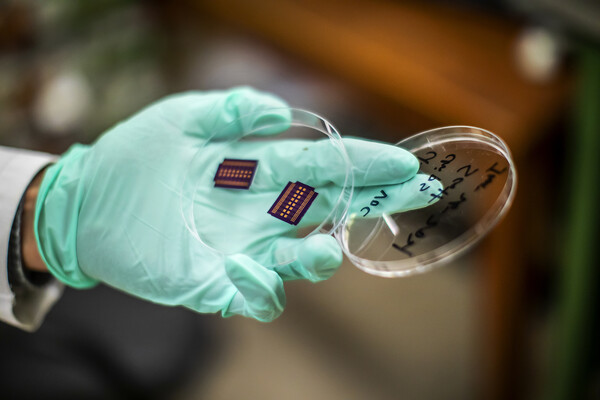Innovation Underway: Covid-19 Odor Technology
A newly researched potential form of scent technology in response to the Covid-19 Pandemic, marks a promising advancement against the struggle with the viral outbreak.
February 10, 2021
The world has been under lockdown since early 2020 as a result of the deadly global pandemic. Originating from Wuhan, China, millions of people have been infected worldwide in a frenzy. Covid is a strain of the deadly disease SARS, which decimated the population years ago. The pathogens are being spread rapidly from animals to humans and scientists are racing to find a solution to combat its spread. Currently, there are approximately 105 million reported cases worldwide of Covid-19. 2.3 million deaths have amassed and almost 58.6M people have recovered from the deadly illness. The entire world is at an alarming halt and the economies of many nations experience an unprecedented slowdown. As scientists around the world conduct research to study the strain, universities such as UPenn Laboratory have found a way to adapt to the current situation and help improve the screening process to mitigate transmission.
Prior to the arrival of the Coronavirus, Penn researchers of the Monell Chemical Senses Center joined together alongside lead physicist, Charlie Johnson, to spearhead a project for tackling disease diagnosis through a specific medium, odor profile. Many diseases such as ovarian cancer tend to alter the body’s life processes and this study was founded to exploit the change in excretion of body odor to develop new methods of detecting unique organic compounds found in subjects who unknowingly carried these diseases. For the past decade, the Penn Vet Working Dog Center has trained dogs to effectively distinguish between the aromas of plasma blood samples from potential ovarian cancer patients, utilizing their powerful sense of smell. With this information, researchers have developed an ‘electronic nose’, capable of mimicking the very same function of compound detection. This sensor was constructed through the use of “carbon nanotubes interwoven with single-stranded DNA.” As of right now, the prototype device has achieved greater than 90% sensitivity rate but researchers plan to enhance its accuracy and further their comprehension of the distinct elements that make up Covid-19’s unique odor profile.
In the first few months of the shutdown, the team of field researchers led by director, Cynthia Otto, collected various samples of t-shirts from people who’d been recently tested from the virus. Over 1,000 samples were taken from both positive and negative, non-hospitalized groups. After being worn overnight and thoroughly absorbing odors, the shirts were sent back to the laboratory for testing. They were placed in glass jars onto the sensor and underwent computer analysis. When the fixed organic signature is obtained, the sensor array discriminates differences between diseases. In total, the device when implemented, can tell if a person is infected with the Covid-19 virus, or if they’re negative. Similar to a dog’s nose, the technology hones in on the individual structure of the odors and produces promising results.
This project was funded through a research grant of $2 million by the National Institutes of Health (NIH). This new innovative device was specifically made in hopes of reversing the outbreak’s effect and supporting contingencies for future pandemics in general. The ultimate goal envisioned for this tech is to become useful for quick-portable, hand-held operation in public. All over the world, this new technology could be introduced and administered in various public screening checkpoints & spaces such as: malls, airports, stadiums, banks, offices, and more. A new generation of fever testing thermal cameras already represent the forefront of technology when it comes to facing this pandemic, but this device will provide a significantly greater way of cracking down on public infections. With the distinctions being made of volatile organic compounds excreting from the skin, this research will give us better insight to understanding Covid-19’s effects on the human body. This odor/aroma sensor technology will undoubtedly progress and aid towards contact-tracing the general public.
Currently, millions of people are quarantined and the shutdown of economies is starting to affect the capital/resources of global nations. With all of these limitations being placed, there are still a multitude of people who visit airports and travel, regardless of the consequences. In response to this dilemma, there has been a new surge of thermal camera technology and mask-detection software to help assess these issues. With this tech, individuals will be identified for signs of Coronavirus and the people they come in contact with can also be traced. Moreover, innovations were created as a result of contact tracing and lanyard/bracelet trackers are prime examples of this. As this new technology proceeds into all parts of the world, the pandemic will gradually slow down and this tech will aid in preventing its further spread and death toll. As the virus continues to take its toll, nations are looking to make breakthroughs in science, medicine, & technology by rolling out vaccines to provide a solution for slowing the spread. Although social distancing and safety equipment has become ubiquitous, infections still pose a major threat to the public safety and welfare of the people. With this new odor technology and tracking software, contact tracing is taken to the next level and will undoubtedly prove beneficial towards combating Covid-19.









